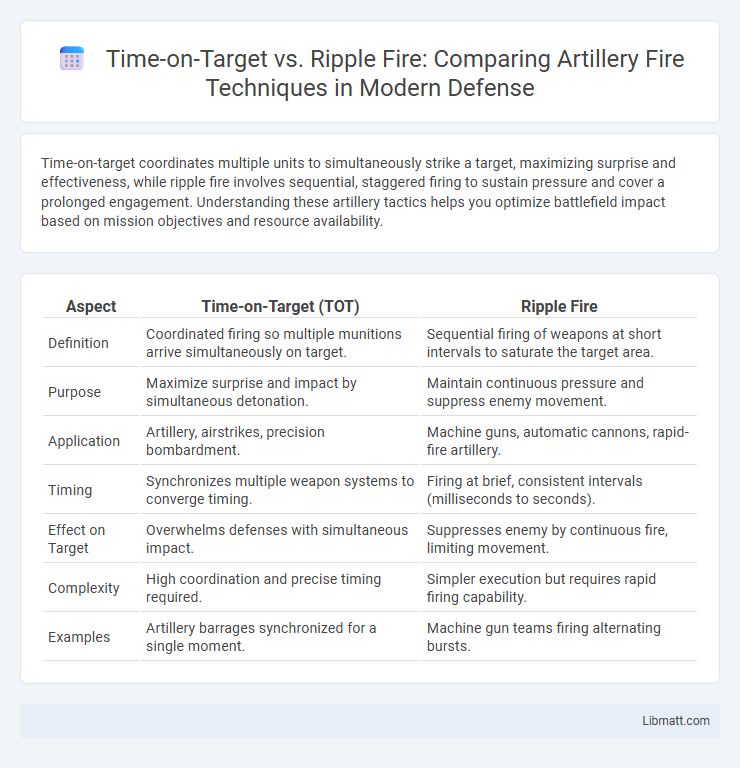Time-on-target coordinates multiple units to simultaneously strike a target, maximizing surprise and effectiveness, while ripple fire involves sequential, staggered firing to sustain pressure and cover a prolonged engagement. Understanding these artillery tactics helps you optimize battlefield impact based on mission objectives and resource availability.
Table of Comparison
| Aspect | Time-on-Target (TOT) | Ripple Fire |
|---|---|---|
| Definition | Coordinated firing so multiple munitions arrive simultaneously on target. | Sequential firing of weapons at short intervals to saturate the target area. |
| Purpose | Maximize surprise and impact by simultaneous detonation. | Maintain continuous pressure and suppress enemy movement. |
| Application | Artillery, airstrikes, precision bombardment. | Machine guns, automatic cannons, rapid-fire artillery. |
| Timing | Synchronizes multiple weapon systems to converge timing. | Firing at brief, consistent intervals (milliseconds to seconds). |
| Effect on Target | Overwhelms defenses with simultaneous impact. | Suppresses enemy by continuous fire, limiting movement. |
| Complexity | High coordination and precise timing required. | Simpler execution but requires rapid firing capability. |
| Examples | Artillery barrages synchronized for a single moment. | Machine gun teams firing alternating bursts. |
Introduction to Artillery Firing Methods
Time-on-target and ripple fire are artillery firing methods designed to optimize battlefield effectiveness by coordinating shell impacts. Time-on-target synchronizes multiple artillery units to deliver rounds simultaneously on a target, enhancing surprise and damage concentration. Ripple fire involves staggered firing sequences, maintaining continuous pressure on the target, allowing you to suppress enemy movements effectively.
Understanding Time-on-Target (TOT)
Time-on-Target (TOT) is a precision artillery tactic designed to synchronize multiple rounds from various firing units to impact a target simultaneously, maximizing damage and surprise. Unlike Ripple Fire, which delivers a continuous stream of rounds at timed intervals, TOT ensures coordinated strikes that overwhelm enemy defenses in a single, concentrated moment. Understanding TOT helps you appreciate its strategic advantage in modern warfare by enhancing the effectiveness and efficiency of combined arms operations.
Explaining Ripple Fire Techniques
Ripple fire techniques involve sequentially firing multiple weapons or launchers in a timed pattern to saturate a target area with munitions, enhancing damage effectiveness and reducing exposure time for units. Unlike time-on-target tactics, which synchronize munitions to arrive simultaneously, ripple fire prioritizes staggered rounds allowing continuous pressure on the enemy. Your strategic choice of ripple fire can optimize resource usage and maintain sustained battlefield dominance by controlling the timing of each volley.
Historical Development of Firing Strategies
Time-on-target and ripple fire emerged as critical artillery firing strategies during World War I, reflecting advancements in coordinated bombardment techniques. Time-on-target focused on synchronizing artillery strikes to hit a target simultaneously, maximizing surprise and impact, while ripple fire involved consecutive, staggered firing to maintain continuous pressure on enemy positions. These methods evolved from the increasing need for precision and efficiency in massed artillery fire, setting foundational tactics in modern artillery doctrine.
Key Differences: Time-on-Target vs Ripple Fire
Time-on-target coordinates multiple artillery units to strike simultaneously at a specific moment, maximizing surprise and damage concentration on the target. Ripple fire involves sequential firing at short intervals, creating a continuous barrage that suppresses enemy movement and reduces counter-battery opportunities. The key difference lies in Time-on-target's synchronized timing versus Ripple fire's staggered, sustained firing pattern.
Tactical Advantages of Time-on-Target
Time-on-target (TOT) enables simultaneous impact of multiple artillery rounds on a single target, maximizing shock effect and overwhelming enemy defenses. This precision coordination reduces the enemy's ability to seek cover or counterattack, enhancing battlefield dominance. The concentrated firepower also improves ammunition efficiency and supports rapid tactical decision-making by commanders.
Operational Benefits of Ripple Fire
Ripple fire enhances operational effectiveness by staggering missile or artillery launches to sustain continuous pressure on the target area, reducing the risk of counterattacks and allowing for better resource management. This method improves air defense evasion and minimizes ammunition waste by optimizing timing intervals between projectiles. The persistent threat created by ripple fire disrupts enemy movements and coordination, increasing the likelihood of mission success.
Situational Effectiveness: Choosing the Right Method
Time-on-target maximizes simultaneous impact by coordinating multiple units to strike a target at once, ideal for overwhelming enemy defenses during high-value target engagements. Ripple fire delivers continuous, rapid successive rounds to maintain pressure, suited for suppressing advancing forces or covering troop movements in dynamic battlefield scenarios. Selecting the appropriate firing method depends on mission objectives, enemy disposition, and the desired balance between shock effect and sustained suppression.
Technological Innovations Impacting Firing Modes
Time-on-target (TOT) and ripple fire represent critical advancements in artillery firing modes, leveraging precise timing and coordination technologies. Innovations such as GPS-guided munitions, automated fire control systems, and real-time targeting data enable TOT to synchronize multiple rounds arriving simultaneously on a target, maximizing battlefield effectiveness. Ripple fire benefits from electronic firing sequences and rapid reload mechanisms, allowing successive barrages to maintain sustained pressure, with both methods transforming modern combat through increased accuracy and lethality.
Conclusion: Optimal Use of TOT and Ripple Fire
Time-on-target (TOT) ensures multiple weapons strike a single target simultaneously, maximizing damage and surprise, while ripple fire delivers sustained, sequential attacks to suppress or overwhelm enemy forces. Your choice between TOT and ripple fire depends on mission objectives: use TOT for precision and synchronized impact, and ripple fire for continuous firepower and area coverage. Balancing these tactics optimally enhances battlefield effectiveness and resource efficiency.
Time-on-target vs Ripple fire Infographic

 libmatt.com
libmatt.com